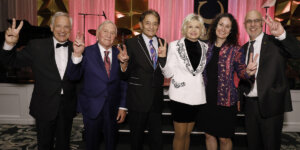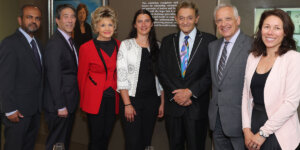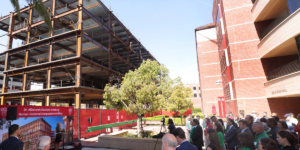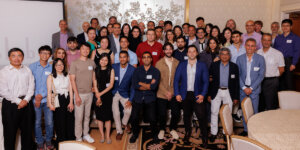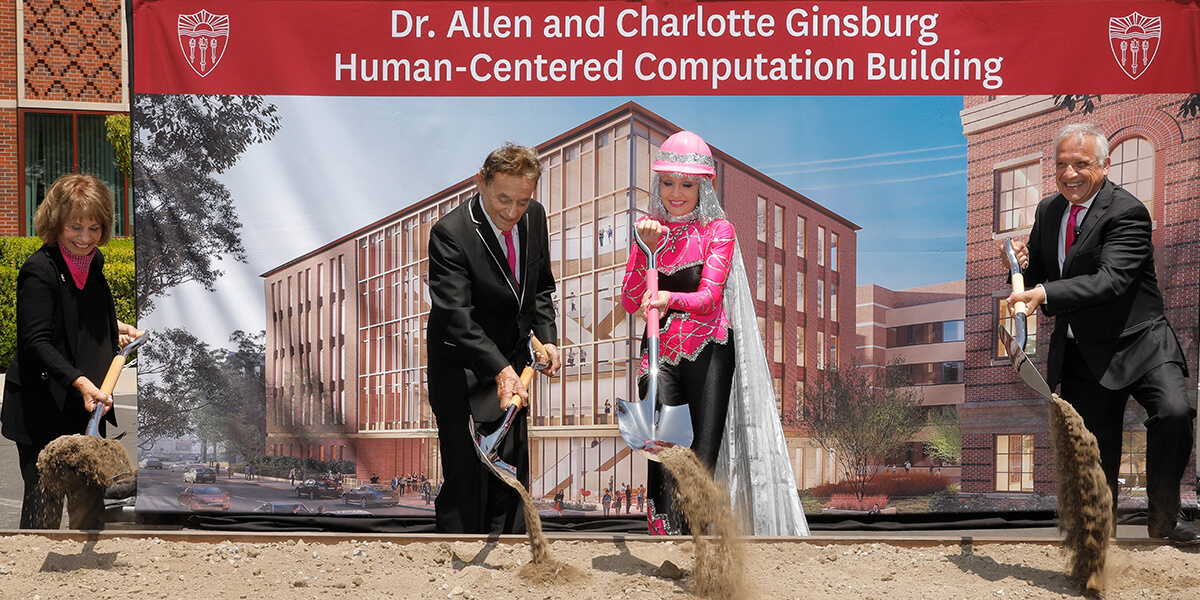
USC President Carol L. Folt, Dr. Allen and Charlotte Ginsburg and USC Viterbi School of Engineering Dean Yannis Yortsos turn the soil. Photo/Steve Cohn.
As the demand for computer science education grows, so, too, does the need for an inspiring space where students and researchers can develop technology, hatch new ideas and forge collaborations — all with human beings at the center. Soon, USC will have such a building, thanks to a lead gift from dedicated USC supporters Dr. Allen and Charlotte Ginsburg.
On Thursday, May 6, the Ginsburgs, with USC President Carol L. Folt and Yannis Yortsos, dean of the USC Viterbi School of Engineering, donned hard hats and put shovels in the ground to start construction on the Dr. Allen and Charlotte Ginsburg Human-Centered Computation Hall.

Dr. Allen and Charlotte Ginsburg. Photo/Steve Cohn.
Opening in 2023, research in the 116,000-square-foot facility will focus on advancing computer science’s role in improving and benefiting society through areas including artificial intelligence, machine learning, robotics and more. A “living lab,” and USC’s first LEED-Platinum certified building, it reinforces USC’s reputation as one of the country’s top research universities.
“We’re so grateful to the Ginsburgs for making USC Viterbi the hub for solving our greatest challenges,” said President Folt during her remarks at the groundbreaking ceremony. “In a way, it’s like chasing the impossible. Except the Ginsburgs don’t see it as impossible; and neither do we.”
The building will become a centralized hub for computer science students and researchers to build robots, create apps, develop AI systems, or test drones for applications such as search and rescue missions. It will provide a home for the USC computer science community and other experts from numerous disciplines across the university as they collaborate on pressing issues like Alzheimer’s disease, cancer, human trafficking and homelessness.
“This facility will be the new home for computer science at USC. One that will help us solve Grand-Challenge-like problems and help advance our mission to engineer a better world for all humanity,” said Dean Yortsos at the event Thursday. He noted that the building will position USC as the gold standard for research and education in engineering, biology, medicine and technology.
A living lab
Plans for the seven-story building, located in USC’s southwest quadrant of campus, include faculty offices, research labs and a departmental administrative and student services suite. A 300-seat auditorium with a 15-foot high video wall can be used for student presentations, hackathons and TED-style talks across the school.
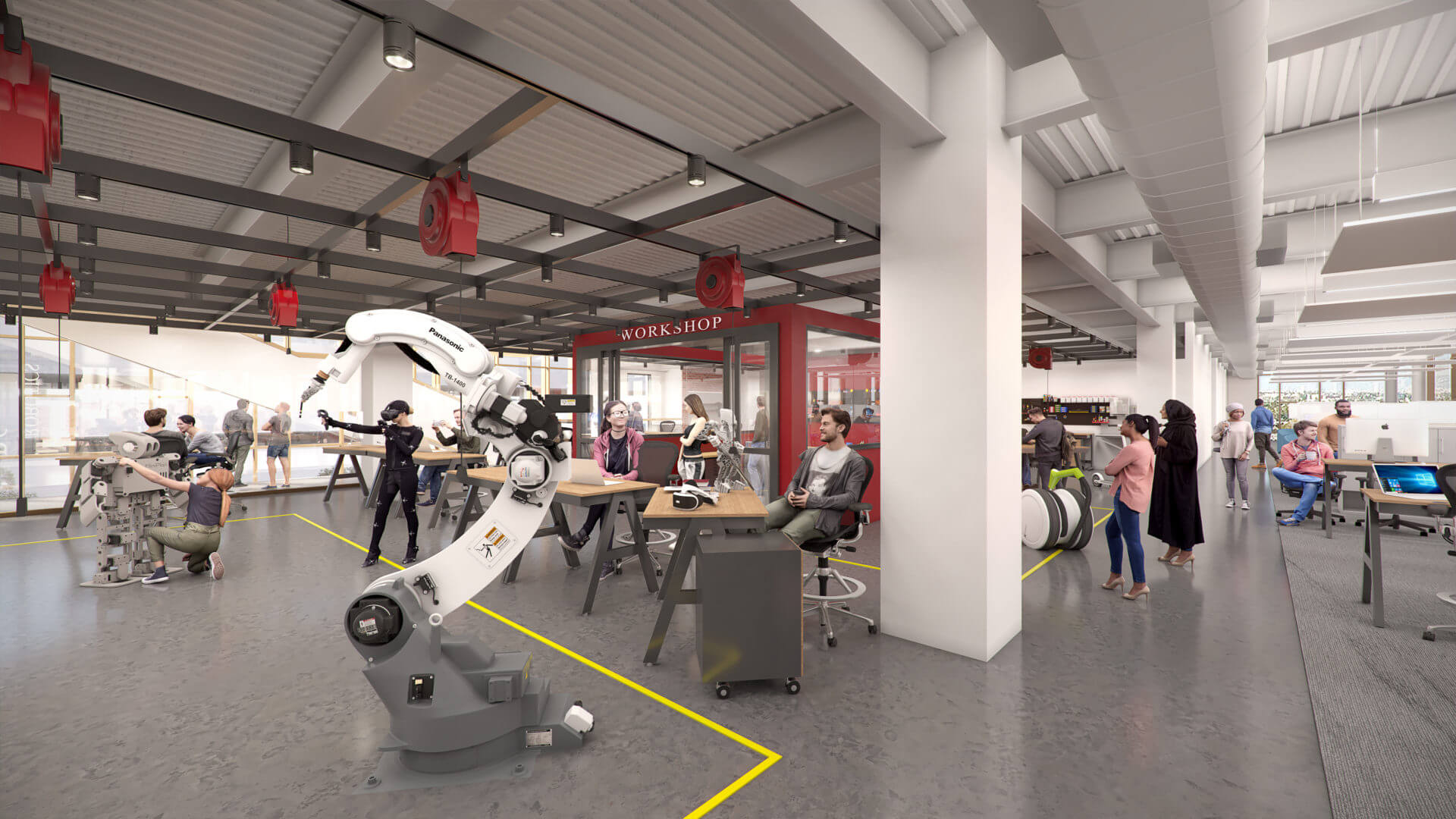
Architectural rendering of the robotics lab.
Flexible collaboration and study spaces are threaded throughout the building, giving students the option to brainstorm on their own or with classmates. Purpose-built labs will be equipped with professional grade equipment for testing and prototyping, including significant space dedicated to robotics labs and an awe-inspiring 25-foot-deep aerial robotics flight area, where researchers and students will develop and test flying robots, including nearly invincible drones that could be the future of disaster relief. Architectural plans show wide and often day-lit staircases and halls, designed to encourage creative collisions between people.
In addition to its technical accomplishments, the building will also be highly sustainable. A state-of-the-art server room makes intensive computing energy efficient; a sunken garden helps conserve and divert water; expansive windows maximize energy savings; and rooftop solar panels generate power. In fact, the building itself will be a “living lab” to study sustainability, fitted with sensors and actuators, producing data that can be analyzed to optimally control the indoor environment with little waste.
A new place to call home
Since its creation in 1968, USC’s Department of Computer Science, in close collaboration with the Information Sciences Institute and the Institute for Creative Technologies, has made invaluable contributions to fundamental areas of computing, including artificial intelligence, natural language processing, cryptography, internet technology, health computing, robotics, software development, virtual reality and computer graphics.
Now ranked among the top 10 in the world for academic research by Microsoft, the building provides the first singular space for computer science at USC, which has witnessed unprecedented growth in the past decade. Since 2011, its student body has tripled and it now boasts more than 80 faculty members, 315 doctoral students, 2,500 master’s students and 1,300 undergraduates. Thirteen new tenure and tenure-track faculty joined the department since fall 2017.
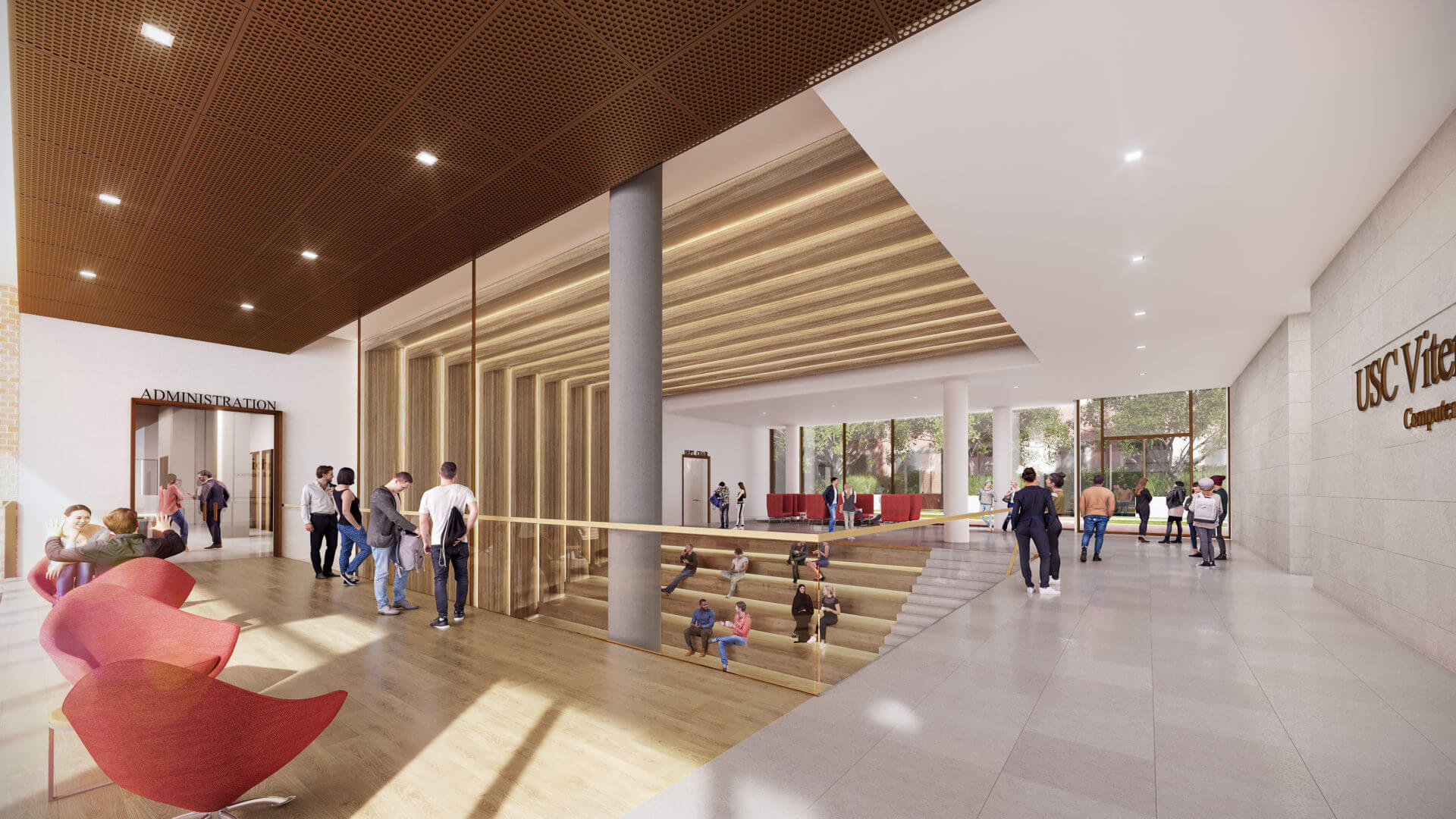
Interior lobby.
By housing computer science at USC, the new building will benefit generations of computer scientists and engineers, researchers, scholars and students who will have a new place to call home. Students like Thomas Groechel, a Ph.D. candidate in Professor Maja Matarić’s Interaction Lab, who is developing educational robots personalized to the learner.
In a recent pilot study, children completed kinesthetic, mixed-reality coding exercises alongside a curious robot tutor. The research, combining socially assistive robots and mixed reality, could also benefit children with autism and the elderly. For Groechel, the labs’ open plan nature will break down walls, both physical and metaphorical.
“For our lab in particular, having a more collaborative and unified space among different labs will allow for more cross-disciplinary expertise to flourish within our research,” said Groechel.
“The biggest thing for me personally is that undergraduates have an easier way to be exposed to research and we will be able to cross collaborate more easily. The open architecture should allow for more exposure to new and potential researchers and will allow us to better showcase our work.”
Dynamic connections
Located adjacent to two existing buildings, the Ray Irani Hall for Molecular and Computational Biology and the Michelson Hall for Convergent Bioscience, the Ginsburg Human-Centered Computation Hall will create a powerful trifecta, reflecting the dynamic connections between computing and medicine, health technology and biology.
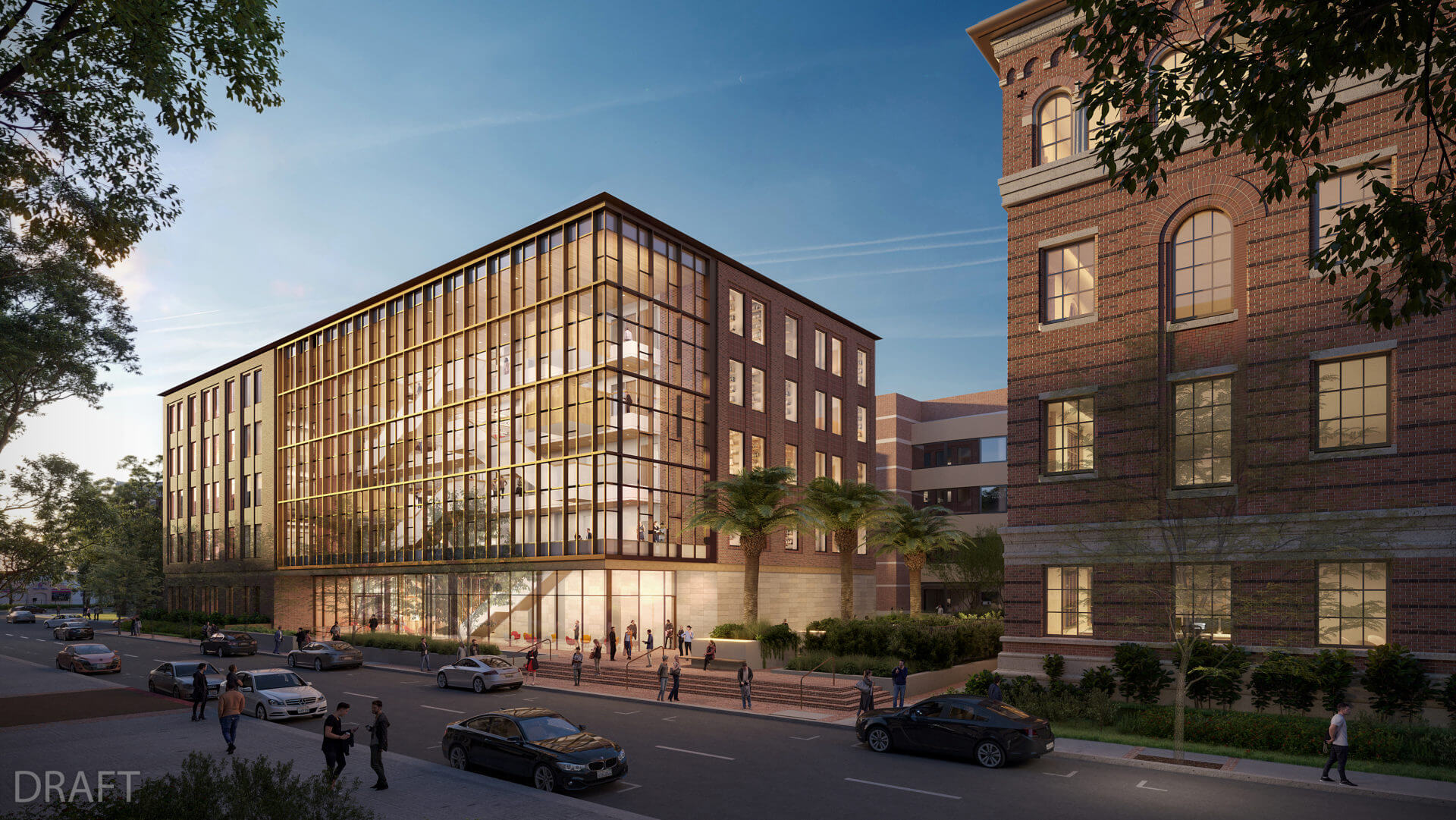
Exterior southeast corner.
“Imagine,” said Gaurav Sukhatme, USC Viterbi’s executive vice dean and the Fletcher Jones Foundation Endowed Chair in Computer Science, “sequencing your genome in nearby Irani Hall, analyzing unique biomarkers for disease with computers at Ginsburg Hall and then finally imaging gene expression over at Michelson Hall.”
Professor Cyrus Shahabi, chair of the Department of Computer Science, describes an ideal scenario in the new building with his frequent collaborator Professor Peter Kuhn, whose laboratory is located in the Michelson Center for Convergent Bioscience. The duo is working on a number of health-related projects, including wearables to help people with cancer get the right treatment.
“In the new building, Professor Kuhn and his students could quickly come to my lab to experiment with these sensors and vice versa,” said Shahabi. “We can have more shared meetings and also do some random brainstorming when we have coffee or lunch on the shared patio.”
Unshakable faith
The building was made possible thanks to a lead gift from dedicated supporters Dr. Allen and Charlotte Ginsburg. Only three years ago, in May 2018 they made their first gift to USC to support the USC Institute for Biomedical Therapeutics, an outgrowth of the Engineering Research Center on BioMimetic Electronic Systems, directed by University Professor Mark Humayun. Little less than two years later, they provided the naming gift for the Dr. Allen and Charlotte Ginsburg Human-Centered Computation Hall.
“Early on, our families have taught us to believe that science and education are crucial in improving the human condition,” said Dr. Ginsburg. “We envision students with beautiful minds in this building challenged to make our planet solve the complex circumstances of the future. It’s so exciting and a privilege for Lady Charlotte and I to be involved in this great adventure.”
Published on May 6th, 2021
Last updated on May 10th, 2021




